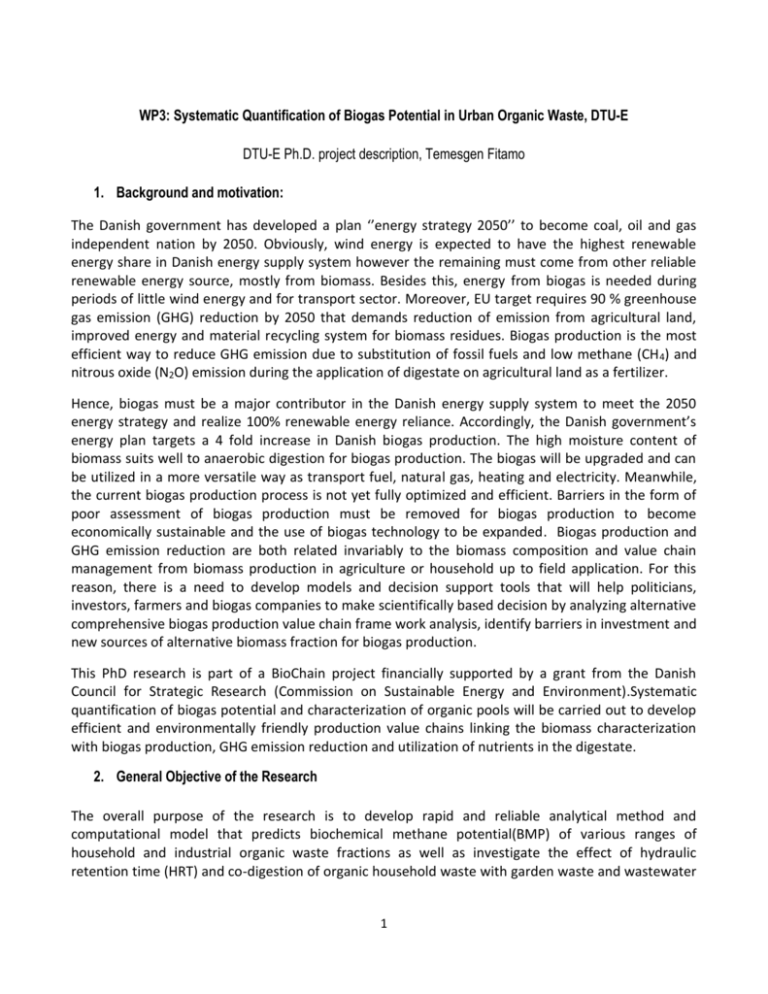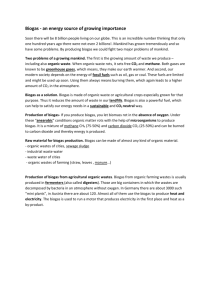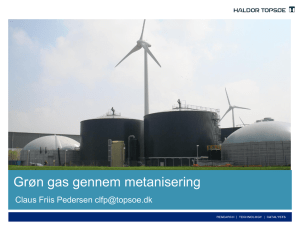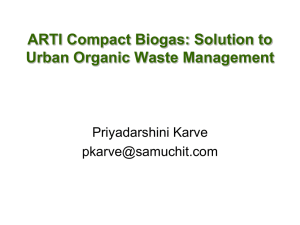Read more.. - Biochain.dk
advertisement

WP3: Systematic Quantification of Biogas Potential in Urban Organic Waste, DTU-E DTU-E Ph.D. project description, Temesgen Fitamo 1. Background and motivation: The Danish government has developed a plan ‘’energy strategy 2050’’ to become coal, oil and gas independent nation by 2050. Obviously, wind energy is expected to have the highest renewable energy share in Danish energy supply system however the remaining must come from other reliable renewable energy source, mostly from biomass. Besides this, energy from biogas is needed during periods of little wind energy and for transport sector. Moreover, EU target requires 90 % greenhouse gas emission (GHG) reduction by 2050 that demands reduction of emission from agricultural land, improved energy and material recycling system for biomass residues. Biogas production is the most efficient way to reduce GHG emission due to substitution of fossil fuels and low methane (CH 4) and nitrous oxide (N2O) emission during the application of digestate on agricultural land as a fertilizer. Hence, biogas must be a major contributor in the Danish energy supply system to meet the 2050 energy strategy and realize 100% renewable energy reliance. Accordingly, the Danish government’s energy plan targets a 4 fold increase in Danish biogas production. The high moisture content of biomass suits well to anaerobic digestion for biogas production. The biogas will be upgraded and can be utilized in a more versatile way as transport fuel, natural gas, heating and electricity. Meanwhile, the current biogas production process is not yet fully optimized and efficient. Barriers in the form of poor assessment of biogas production must be removed for biogas production to become economically sustainable and the use of biogas technology to be expanded. Biogas production and GHG emission reduction are both related invariably to the biomass composition and value chain management from biomass production in agriculture or household up to field application. For this reason, there is a need to develop models and decision support tools that will help politicians, investors, farmers and biogas companies to make scientifically based decision by analyzing alternative comprehensive biogas production value chain frame work analysis, identify barriers in investment and new sources of alternative biomass fraction for biogas production. This PhD research is part of a BioChain project financially supported by a grant from the Danish Council for Strategic Research (Commission on Sustainable Energy and Environment).Systematic quantification of biogas potential and characterization of organic pools will be carried out to develop efficient and environmentally friendly production value chains linking the biomass characterization with biogas production, GHG emission reduction and utilization of nutrients in the digestate. 2. General Objective of the Research The overall purpose of the research is to develop rapid and reliable analytical method and computational model that predicts biochemical methane potential(BMP) of various ranges of household and industrial organic waste fractions as well as investigate the effect of hydraulic retention time (HRT) and co-digestion of organic household waste with garden waste and wastewater 1 treatment primary sludge in continuous stirred tank reactor (CSTR) and also quantification of fugitive greenhouse gas (GHG) emissions from full scale biogas production processes. Please, see appendix A for more detailed information on the methodologies and deliverables. 3. Methodology: Activity 1: Rapid Biochemical methane potential (BMP) Analysis Partial least square (PLS) model will be built using BMP data from batch assay (VDI 4630) and NIR spectra obtained with optimal data pre-processing. The spectra and methane yield of household and industrial organic waste fractions will be input to develop a computational model that predicts BMP. Activity 2: Co-digestion and Effect of HRT on biotransformation of organic pools in CSTR’s The proposed test involves running continuous stirred tank reactors (CSTRs) with household waste, co-digestion of household waste and garden waste (green waste), co-digestion of wastewater treatment plants (WWTPs) primary sludge and household waste and also digestion of primary sludge without co-substrate at various hydraulic retention time (HRT) and optimal biogas production reactor condition. Inoculum will be collected from waste water treatment plant anaerobic digesters and also from reactors running with household waste as feedstock. Activity 3: Quantification of Fugitive Emissions The rate of fugitive greenhouse gas (GHG) emission is computed based on measured downwind plumes of greenhouse gases in an appropriate distance from the biogas plant that in turn will be compared to known rate of released tracer gas at the emission source. The atmospheric concentration will be measured by methane/acetylene and nitrous oxide/nitrate analyzers, based on cavity ring analytical approach. The analyzers have GPS feature to relate the measured concentrations with the local geographical area. 4. Deliverables: The expected outcome of the research based on NIR analysis is rapid and reliable analytical method and computational model that predicts biogas production. The outcome of CSTRs research is kinetic constant parameter, detailed physicochemical characteristics of substrates and co-substrates during anaerobic conversion and physicochemical composition of digestate. Quantification of fugitive GHG emissions from a full scale biogas plant. 2 5. Timeline of Activities CSTR,BMP Model Development & Quantification of Fugitive Emission CSTR 1: HHW & HHW+GW CSTR2:HHW & HHW+GW CSTR3:HHW & HHW+GW CSTR4:Sludge & Sludge + HHW CSTR5:Sludge & Sludge + HHW CSTR6:Sludge & Sludge + HHW Batch BMP Assay Set Up & NIR 1 Batch BMP Assay Set Up & NIR 2 Batch BMP Assay Set Up & NIR 3 Batch BMP Assay Set Up & NIR 4 Batch BMP Assay Set Up & NIR 5 Batch BMP Assay Set Up & NIR 6 BMP PLS Model development Mass Balance Fugitive emission measurement campaign Fugitive emission Quantification Journal Article manuscript writing Ph.D Thesis writing 2014 AprJulMar Jun Sept X X X X X X OctDec JanMar 2015 AprJulJun Sept OctDec JanMar 2016 AprJun JulySept OctNov X X X X X X X X X X X X X X X X 3 X





